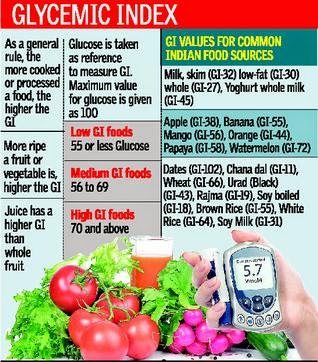The GI represents the total rise or fall in a person's blood sugar level following consumption of the food.While diabetics keep a tab of carbohydrates,calories and sugar levels it is necessary to keep a track of the GI levels of food too. Very little information is available regarding GI values of food and its impact on diabetes.
Diabetes patients need to keep track of
1)Calories
2)Carbohydrates
3)GI values of food
Keep track of all the three aspects for a balanced diet.Oats has a high GI but a low glycemic load for the quantity typically consumed.
GI value of food may be affacted by a number of factors
1)Method of cooking - baking,frying etc
2)Processed food,ripening of fruits and vegetables
3)Fats and proteins lower the GI of food .For example chocolate has a medium GI because of its fat content .
Fried foods like puris have low GI but high in carbohydrates so a balance should be maintained.
A low-GI food will release glucose more slowly and steadily, which leads to more suitable postprandial (after meal) blood glucose readings. A high-GI food causes a more rapid rise in blood glucose levels and suitable for energy recovery after exercise or for a person experiencing hypoglycemia.Consuming carbohydrates with a low glycemic index and calculating carbohydrate intake would produce the most stable blood sugar levels.Here is a chart regarding glycemic index courtesy The Hindu useful for diabetes , those who need to lose weight etc.
 |
| Image courtesy :The Hindu |
It should be understood that each person should have a different and customised diet plan designed for them to control their sugar levels
Comments
Post a Comment